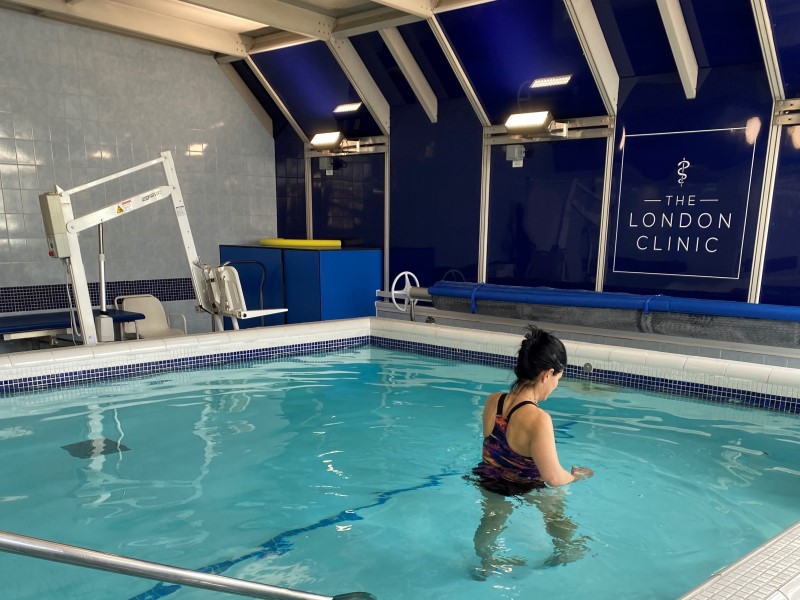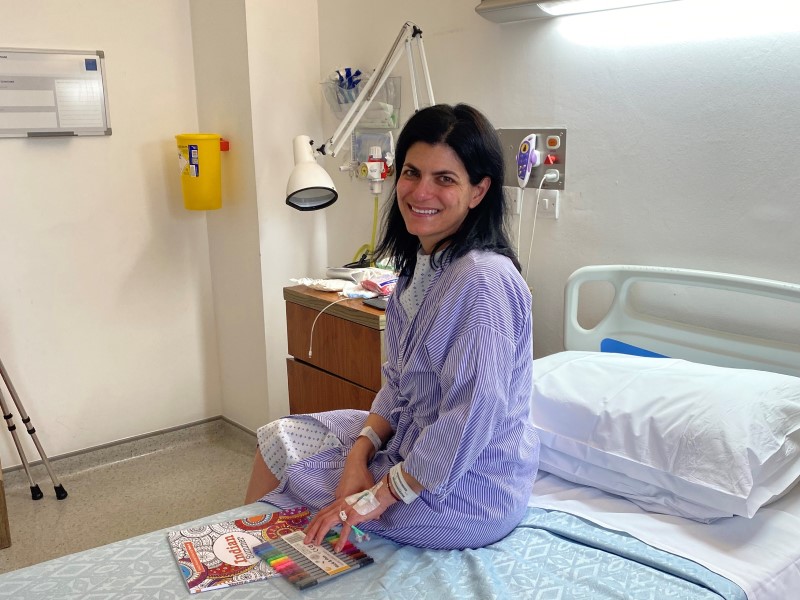What were your initial symptoms and how were you diagnosed?
I’ve always enjoyed keeping fit, though activities such as weight training and running. However, I unfortunately started to experience pain in my groin and lower back.
Weight training became a struggle as it required me using my hips as a hinge. But running was also very painful. Eventually, even taking long walks was difficult.
After realising that no amount of acupuncture or physiotherapy was going to change things, I started seeing a sports physician.
After an MRI scan, the physician diagnosed me with a labral tear and an anterior femoroacetabular impingement (AFI). This is when extra bone grows along the bones that form the hip joint, meaning that the ball-and-socket joint doesn’t fit together perfectly, causing friction during movement.
I was referred to see Mr Marcus Bankes, an Orthopaedic Surgeon and Consultant at The London Clinic, who specialises in general orthopaedic and hip surgery.

What impact has the trouble with your hip had on your life?
From being someone who ran around four times a week and raced at least once per month, not being able to run was something I really struggled with.
As the pain progressed, I also found it extremely difficult to sleep. I don’t think I slept properly for over a year!
What’s more, I was experiencing this during the lockdowns last year, when going on walks with friends and family was one of the only ways we were permitted to socialise. I wasn’t able to do this, so it was a difficult time.
What was the most challenging aspect of dealing with your hip?
It was the sleep deprivation and inability to do the things I love to do. That wasn’t just keeping active – I even struggled with sitting still for long periods of time.
What treatment(s) did you undertake at The London Clinic and what did it involve?
My first surgery was a right hip arthroscopy in June 2020 at The London Clinic. That’s a minimally invasive procedure whereby the surgeon views the joint.
They then repaired my labral tear and “shaved” my hip joint so that it fit more securely into the joint.
Following that surgery and while I was an inpatient, I received hydrotherapy in the hospital’s aquatic therapy pool.
After that, I had face-to-face physiotherapy sessions and continued my rehabilitation exercises at home, mainly on my stationary exercise bike, as the pandemic meant we mainly needed to stay indoors.
Then it came to my second hip arthroscopy in December 2020. Unfortunately, this wasn’t successful, which meant that I underwent a full hip replacement in May 2021.
I experienced so many mixed emotions before that surgery – I was nervous, scared and excited all at the same time. It all went very well, as did the physiotherapy that followed.

What led you to want to document your journey on Instagram?
In April 2021, shortly before my full hip replacement, I decided to start sharing my story with others, particularly those who had experienced similar issues.
When you’re going through something like this and don’t know what to expect, it’s comforting to hear and learn from other people’s experiences. It helps you to feel better prepared.
I documented many aspects of my journey on Instagram. For example, after being told that I had high levels of inflammation, I changed my diet to see if that would help.
I cut out eggs, processed sugar and dairy, and started drinking celery juice and taking pre-biotics.
Although I made these changes after doing my own research on inflammation, I saw a real difference in my pain levels.
There were some weeks, such as Jewish New Year, where I’d have a bit more sugar than I usually would and could feel the difference in how my hip felt.
What has the recovery process looked like since your operation?
The first two weeks after my hip replacement I did lots of aqua therapy in the pool. After four weeks, I started doing land physiotherapy every day.
Five weeks after that, I started seeing my own physiotherapist once a week. Every session was progress and I soon began swimming rehabilitation three times a week and physiotherapy on the days I didn’t swim.
Those sessions involved building up my glute strength, cycling on my indoor bike, or weighted step ups, but I also slowly increased the amount of walking I did and I stretched every morning.
I’m now 15 weeks post-surgery. Although my hip is still quite weak, I’m seeing real improvements on what I can achieve. This week I was finally able to do a child’s pose in yoga!
However, there’s compromise involved – I can go for long walks with friends but I do need to stretch and get moving before we go.
During this whole process, I’ve learnt so much about myself. My resilience, appreciation, gratitude and determination. But most importantly respect. Respect for my body and what it can and can’t do, and learning to know when to pause.
Due to the trauma to both my hip joint and mental health in the years before my operation, I wasn’t physically strong before surgery. And that’s okay.
My tip for others is that it’s your own race, and no one can run the race except from you. Every case is different and you should go at your own pace.
Is there anything you’ve found particularly helpful in your recovery journey?
I’m a runner at heart, but since I haven’t been able to run, getting back into swimming felt like I was getting closer to being fit and active again. I loved hydrotherapy sessions!
Have there been any memorable moments during your journey to recovery?
The most memorable moment was leaving the hospital! But I’ve also loved seeing my own progress.
I’ve been religious in tracking and celebrating the advancements I make. They’re just simple things that others may take for granted, but for me they’re special moments.
What has surprised you the most about your journey and/or hip replacement?
How painless – literally – it was and how mobile I was post-surgery. I was expecting the worst and was amazed that the first day after my surgery I was up and walking around the room and ward on my crutches. The hospital’s Physiotherapy team were amazing.
Has your perception on hip replacements changed and if so how?
Yes – they’re not so bad! I really was expecting the worst and was dreading my operation.
I think the biggest misconception is that hip replacements are only for the elderly, but they’re not.
I’ve learnt that many, many younger people have hip replacements and they do get back to their prior level of fitness. Obviously, this takes time and dedication to achieve, but it’s doable.
What are your plans for the future?
To be able to run. I’m aiming for this year, but it may need to be 2022 depending on my recover. Being able to take part in races again, such as a half marathon, would be incredible.
A clinical perspective
Physiotherapy is integral to recovery following a total hip replacement, and The London Clinic’s Physiotherapy team is involved in patient care from day one.
Initially, the physiotherapist will teach each patient exercises to perform in their hospital bed, helping to engage hip muscles and support movement on the newly operated limb.
This will lead to basic functional activities, such as getting in and out of bed, practicing walking and climbing stairs with crutches, and promoting a quality gait pattern, with good symmetry and safety.
Inpatients will also receive aquatic therapy – a form of exercise in our pool, guided by trained physiotherapists. The properties of the water help to support and promote early function.
This includes buoyancy to support the painful muscles and joints to move; warmth, which can reduce painful muscle spasm and improve circulation; and drag resistance, which allows muscles to exercise against gentle resistance provided by the water.
Once home, the patient will be provided with exercises to continue on land.
However, even once discharged we advise patients to attend outpatient physiotherapy with one of our experienced and specialist musculoskeletal physiotherapists.
This is so that the physiotherapist can set individual functional goals with you.
We will then work towards achieving these goals utilising a combination of exercise, education and hands-on treatment to restore movement, muscle strength, function, symmetry and confidence.
Your physiotherapist will develop an individualised exercise programme with you, making use of our well-equipped physiotherapy gym, which contains static bikes, cross trainer, treadmill and anti-gravity treadmill, Keiser wall pulley system, barbell and free weights, equipment for re-training balance, and Biodex and dynamometer muscle testing equipment.
Further information
Find out more about our physical therapies.
If you do not live locally we can offer remote physiotherapy from the comfort of your own home via our video consultation platform, Connect.





